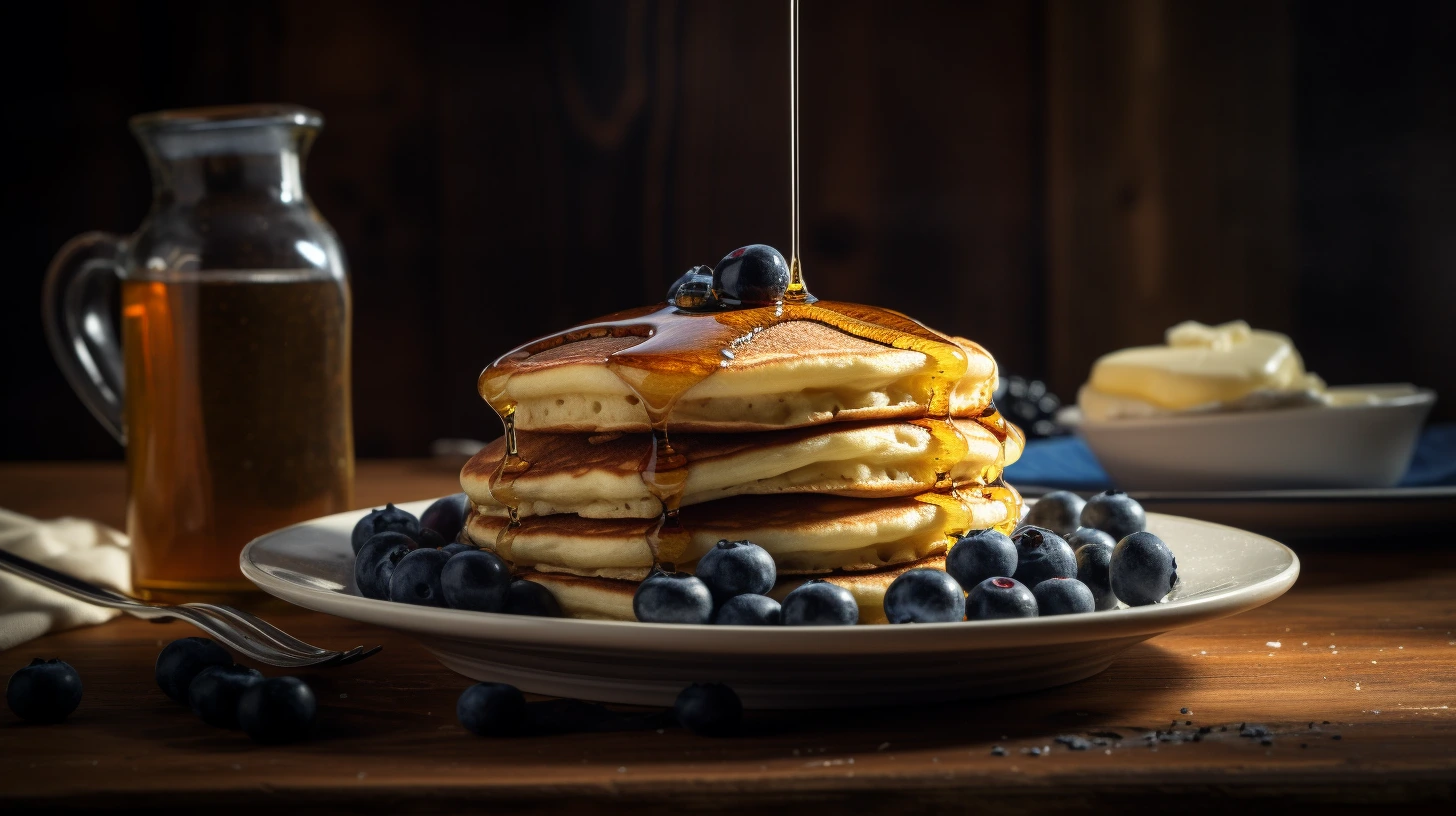Protein in blueberry pancakes adds nutritional value to this beloved breakfast staple, making it both delicious and nourishing. The protein in blueberry pancakes makes them both a delicious and nutritious breakfast choice. These beloved breakfast staples are enjoyed worldwide for their fluffy texture and bursts of juicy, sweet blueberries. Combining the simplicity of pancakes with the natural goodness of blueberries creates a dish that is comforting, flavorful, and packed with nutritional benefits. Let’s dive into what makes blueberry pancakes special, their protein content, and the key ingredients that create their foundation.
Table of contents
- What Makes Blueberry Pancakes Unique?
- Nutritional Composition of Blueberries in High-Protein Blueberry Pancake
- Calculating Protein in High-Protein Blueberry Pancakes
- Blueberry Pancakes and Dietary Goals
- Protein Needs Based on Age, Gender, and Activity Level
- General Guidelines
- Protein Needs by Age and Gender
- Additional Considerations
- Are Blueberry Pancakes Suitable for High-Protein Diets?
- How to Increase Protein in Blueberry Pancakes
- Are They Suitable for Low-Carb, High-Protein Diets?
- Sample High-Protein Blueberry Pancake Recipe
- Conclusion: High-Protein Blueberry Pancakes as a Nutritious Breakfast Staple
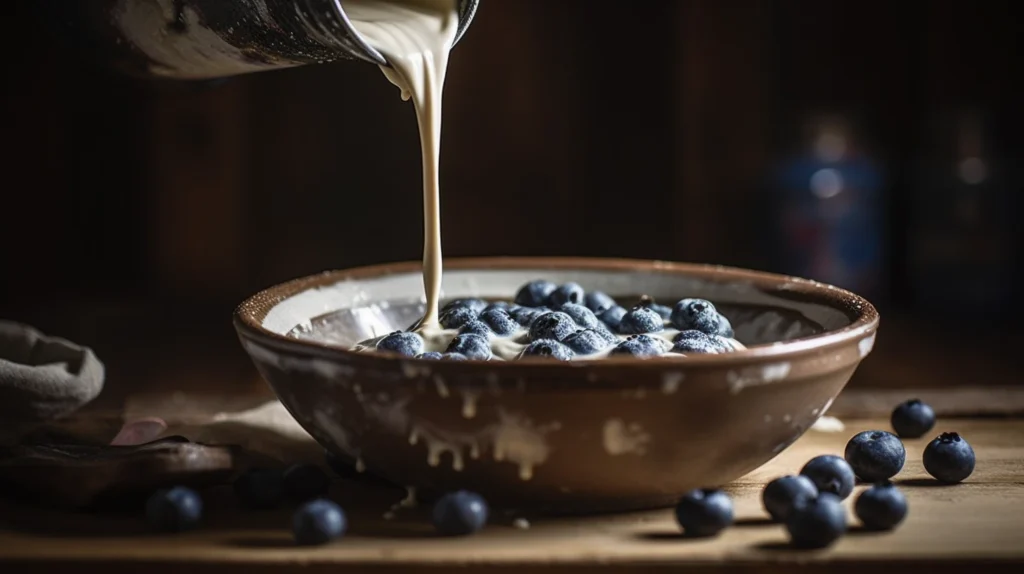
What Makes Blueberry Pancakes Unique?
Blueberry pancakes stand out due to the delightful combination of the pancake’s tender, slightly sweet base and the vibrant flavor of blueberries. Each bite offers a contrast of textures, with the soft pancake surrounding the juicy berries. The blueberries not only enhance the taste but also bring a touch of nature’s artistry to the dish with their deep blue-purple hues. When cooked, these berries release a mild tartness, creating a balance that prevents the pancakes from being overly sweet. The protein in blueberry pancakes adds to their appeal by making them a satisfying meal that blends taste and nutrition.This perfect harmony of flavors and textures makes blueberry pancakes a universally.
Nutritional Composition of Blueberries
Blueberries are a superfood packed with vitamins, minerals, and antioxidants. When combined with protein-rich ingredients, blueberries enhance the nutritional value of pancakes, making them a well-balanced breakfast choice. Here’s what makes them a valuable addition to pancakes:
- Rich in Antioxidants: Blueberries contain high levels of anthocyanins, which are compounds responsible for their vibrant color and health benefits. These antioxidants help defend the body against oxidative stress and inflammation.
- Low in Calories: A cup of blueberries contains only about 84 calories, making them a guilt-free addition to pancakes.
- High in Fiber: Blueberries are a good source of dietary fiber, which supports digestive health and promotes a feeling of fullness.
- Vitamin C and K: These vitamins play essential roles in immune support, skin health, and bone health.
- Natural Sweetness: Blueberries provide a natural sweetness, reducing the need for added sugars in pancake recipes.
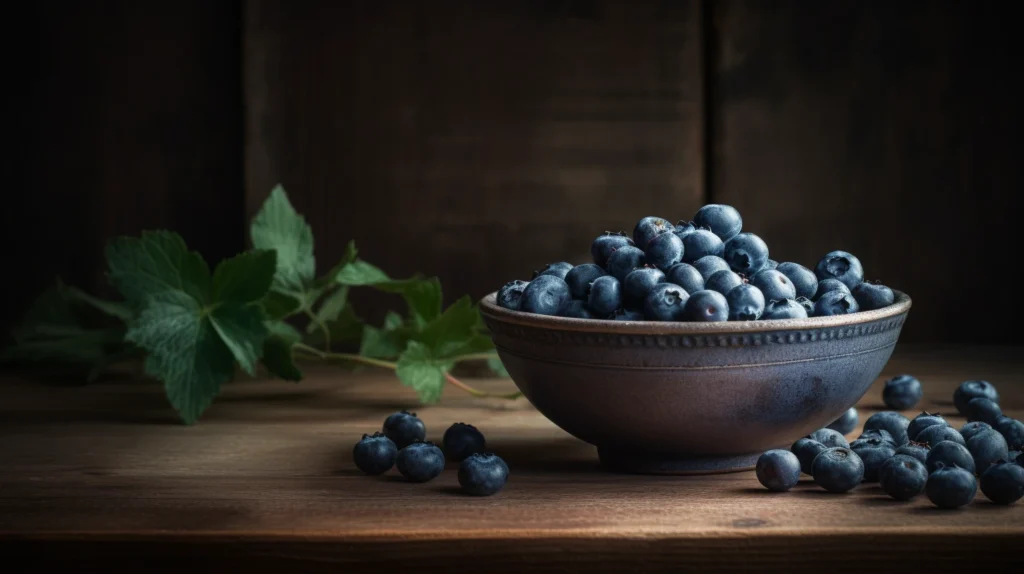
The Basics of Pancake Ingredients
While blueberries elevate the dish, the foundation of a great pancake lies in its basic ingredients. A simple pancake batter typically includes:
- Flour: The primary structure of pancakes comes from all-purpose flour. For a healthier twist, whole wheat or gluten-free flours can be used.
- Leavening Agents: Baking powder or baking soda is used to create a light, fluffy texture by introducing air into the batter.
- Milk: Adds moisture and richness. Dairy milk or plant-based alternatives like almond, oat, or soy milk can be used.
- Eggs: Add structure and act as a binding agent for the ingredients, flaxseed or chia seed mixtures are great substitutes.
- Butter or Oil: Butter or Oil: Enhances flavor and prevents the pancakes from sticking to the pan.
- Sweetener: A touch of sugar, honey, or maple syrup enhances the flavor without overpowering it.
- Salt: A small amount balances the sweetness and enhances the overall flavor.
When these simple ingredients are combined with fresh blueberries, the result is a pancake batter that transforms into a delicious breakfast treat.
Blueberry pancakes are not just a meal; they are an experience—a fusion of flavor, nutrition, and comfort. Protein in blueberry pancakes primarily comes from ingredients like eggs, milk, and optional add-ins such as Greek yogurt or protein powder. Whether enjoyed with a drizzle of maple syrup or a dollop of whipped cream, they are a delightful way to start any morning.
Nutritional Composition of Blueberries in High-Protein Blueberry Pancake
Pancakes are traditionally viewed as a carbohydrate-rich breakfast, but the inclusion of certain ingredients can significantly boost their protein content. Here’s a breakdown of key protein contributors in blueberry pancakes:
Main Protein Sources:
- Eggs: A staple in most pancake recipes, one large egg provides about 6 grams of protein.
- Milk: Whether dairy or plant-based, milk adds protein to your pancakes. For instance, one cup of cow’s milk provides 8 grams of protein.
- Flour: While not a major source, ¼ cup of all-purpose flour contains about 3 grams of protein.
- Blueberries: While low in protein (1 gram per cup), they add essential vitamins and antioxidants.
For a creative spin on incorporating nutrient-dense ingredients into your pancakes, check out Cottage Cheese Brownies that Are Sweet, Simple, and Nutritious for high-protein and guilt-free indulgence ideas.
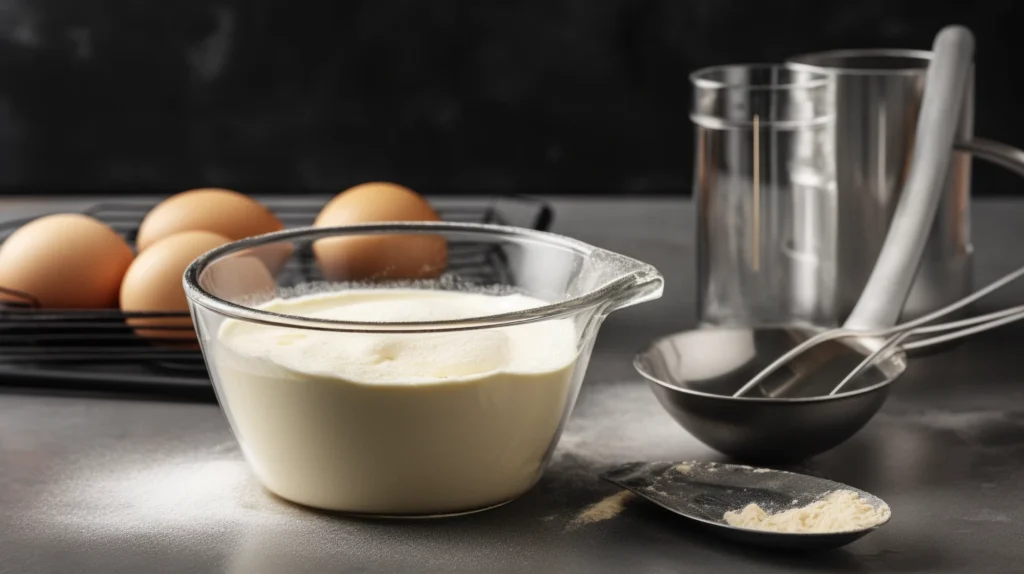
Sources of Protein in Standard and High-Protein Blueberry Pancake Recipes
The protein content in pancakes comes from several key ingredients commonly used in their preparation:
- Eggs: Eggs are a primary source of protein in pancake recipes. A single large egg contains about 6 grams of high-quality protein, contributing both structure and nutritional value to the batter.
- Milk: Dairy milk adds protein, with an average cup containing about 8 grams. Plant-based alternatives, such as soy milk, are also good protein sources, though options like almond or oat milk provide less.
- Flour: While not a significant protein source, wheat-based flours contain some protein (about 3 grams per ¼ cup), contributing to the overall protein content of the dish.
- Butter or Oil: While these ingredients provide flavor and texture, they do not contribute protein.
- Optional Add-ins: Ingredients like Greek yogurt, cottage cheese, or protein powders can be incorporated to boost the protein content significantly.
Comparing Pancakes Made with Different Flours for High-Protein Blueberry Pancakes
The type of flour used in pancake recipes can influence both the texture and protein content of the final product. Here’s a comparison of common options:
1. All-Purpose Flour
- Protein Content: About 3 grams per ¼ cup.
- Characteristics: All-purpose flour is the traditional choice for pancakes, offering a neutral flavor and soft texture. While its protein content is moderate, it is not a complete protein source and is often paired with other ingredients like eggs or milk for balance.
2. Whole Wheat Flour
- Protein Content: About 4 grams per ¼ cup.
- Characteristics: Whole wheat flour provides more protein and fiber than all-purpose flour, making it a healthier option. It adds a nutty flavor and denser texture to pancakes.
3. Almond Flour
- Protein Content: About 6 grams per ¼ cup.
- Characteristics: Almond flour is a popular gluten-free alternative that significantly increases protein content. Made from finely ground almonds, it adds a rich, slightly sweet flavor to pancakes and works well in low-carb or grain-free recipes.
4. Oat Flour
- Protein Content: About 4 grams per ¼ cup.
- Characteristics: Oat flour is made from finely ground oats and provides a heartier texture and mild, nutty flavor. It is also a gluten-free option when certified oats are used.
5. Chickpea Flour
- Protein Content: About 6 grams per ¼ cup.
- Characteristics: Chickpea flour, made from ground chickpeas, is another gluten-free option with a high protein content. It has a distinctive earthy flavor and works well in savory pancake recipes.
6. Protein-Enriched or Blended Flours
- Protein Content: Varies but can contain 10+ grams per serving.
- Characteristics: Protein-enriched flours or blends often combine traditional flours with added protein sources like whey or plant-based protein powders, making them ideal for high-protein pancakes.
Calculating Protein in High-Protein Blueberry Pancakes
Blueberry pancakes can be as nourishing as they are delicious, especially when you know how to calculate the protein content. Calculating the protein in blueberry pancakes is straightforward with a step-by-step approach. Understanding the protein in your pancakes requires examining the ingredients and their quantities. Here’s a detailed guide to estimating the protein content in homemade pancakes and comparing pre-made mixes with scratch-made recipes.
Step-by-Step Guide to Estimating Protein in High-Protein Blueberry Pancakes
To calculate the protein in your blueberry pancakes, follow these steps:
- List the Ingredients
Identify all the ingredients in your pancake recipe, including blueberries, flour, eggs, milk, and any additional protein-rich items like Greek yogurt or protein powder. - Determine Serving Size
Decide how many pancakes or servings the recipe yields. This will help you calculate the protein content per serving. - Find Protein Content Per Ingredient
Use nutritional labels or databases to find the protein content of each ingredient based on the quantity used. - Add It Up
Sum the protein contributions from all ingredients to get the total protein content for the batch. - Divide by Servings
Divide the total protein by the number of servings to calculate the protein content per serving or pancake.
Sample Calculations for Homemade Pancakes
Example Recipe: Blueberry Pancakes (Serves 4)
Ingredients:
- 1 cup all-purpose flour: ~3g protein
- 1 cup milk: ~8g protein
- 1 large egg: ~6g protein
- 1 cup fresh blueberries: ~1g protein
- 1 tbsp butter: 0g protein
Total Protein:
- Flour: 3g
- Milk: 8g
- Egg: 6g
- Blueberries: 1g
- Butter: 0g
Total for Batch: 18g protein
Protein Per Serving:
- 18g ÷ 4 servings = 4.5g protein per serving
Boosting Protein Content
To increase protein:
- Use almond flour instead of all-purpose flour (+6g per cup).
- Add 2 tbsp protein powder (+10g).
- Include ¼ cup Greek yogurt (+5g).
Pre-Made Mixes vs. Scratch-Made Pancakes
Pre-Made Pancake Mixes
- Pros: Convenient and quick; many brands offer protein-enriched options.
- Cons: May include added sugar, preservatives, and lower-quality protein sources.
Example:
- ½ cup of a protein-enriched mix: ~10g protein (including milk/eggs).
Scratch-Made Pancakes
- Pros: Full control over ingredients; no added preservatives; adaptable to dietary preferences.
- Cons: Requires more preparation time and effort.
Example:
Homemade blueberry pancakes with protein powder and Greek yogurt: ~15-20g protein per serving.
Blueberry Pancakes and Dietary Goals
Blueberry pancakes can be a versatile addition to many diets, but their suitability depends on individual nutritional needs and dietary goals. While they are commonly enjoyed as a carbohydrate-focused breakfast, their protein content can be adjusted to align with specific requirements.
Protein Needs Based on Age, Gender, and Activity Level
Protein requirements vary depending on factors such as age, gender, and physical activity. Here’s a breakdown of how these factors influence daily protein needs:
General Guidelines
- The Recommended Dietary Allowance (RDA) for protein is 0.8 grams per kilogram of body weight for the average adult.
- Active individuals, athletes, and those looking to build or maintain muscle mass often require higher protein intake, ranging from 1.2 to 2.0 grams per kilogram of body weight.
Protein Needs by Age and Gender
- Children (4–13 years): 19–34g of protein per day, depending on age and weight.
- Teenagers (14–18 years):
- Boys: ~52g per day
- Girls: ~46g per day
- Adults (19+ years):
- Men: ~56g per day
- Women: ~46g per day
- Older Adults: Increased needs of 1.0–1.2 grams per kilogram of body weight to counteract muscle loss.
Additional Considerations
- Pregnant and Breastfeeding Women: Require an additional 25g of protein daily.
- Athletes: Protein needs increase to 1.2–2.0 grams per kilogram to support muscle repair and recovery.
Are Blueberry Pancakes Suitable for High-Protein Diets?
While traditional blueberry pancakes are not inherently high in protein, they can be made suitable for high-protein diets with a few modifications:
How to Increase Protein in Blueberry Pancakes
- Use Protein-Rich Flours
- Replace all-purpose flour with almond flour, chickpea flour, or protein-enriched flours.
- This can add 4–6 grams of protein per serving.
- Incorporate Protein Powder
- Add 1–2 tablespoons of whey, casein, or plant-based protein powder to the batter.
- Each tablespoon typically adds 8–10 grams of protein.
- Enhance with Greek Yogurt or Cottage Cheese
- Mix these into the batter or use them as a topping.
- Greek yogurt adds about 5g of protein per ¼ cup, while cottage cheese adds up to 14g per ½ cup.
- Use More Eggs
- Increase the number of eggs in the recipe. Each egg contributes about 6 grams of protein.
- Top with Nut Butter or Nuts
- Spread almond or peanut butter over the pancakes, or sprinkle chopped nuts for an additional 4–7 grams of protein per tablespoon.
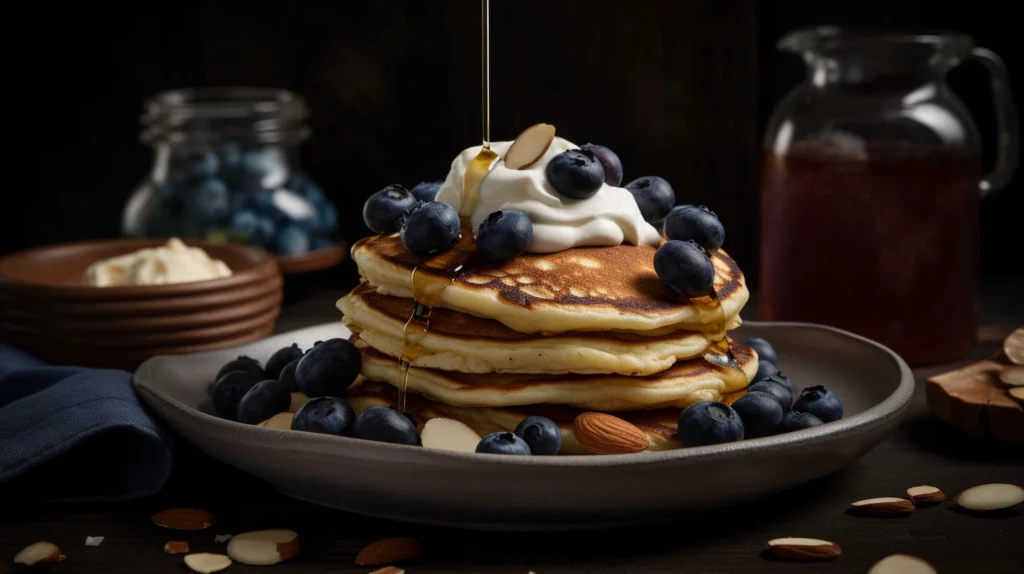
Are They Suitable for Low-Carb, High-Protein Diets?
Blueberry pancakes can be adapted for low-carb, high-protein diets by:
- Using almond or coconut flour instead of wheat flour.
- Sweetening with a sugar substitute like stevia or erythritol.
- Limiting the number of blueberries to reduce the overall carbohydrate content.
Sample High-Protein Blueberry Pancake Recipe
- ½ cup almond flour
- 2 eggs
- 1 tbsp protein powder
- ¼ cup Greek yogurt
- ½ cup fresh blueberries
- Protein Content: ~20–25 grams per serving
Conclusion: High-Protein Blueberry Pancakes as a Nutritious Breakfast Staple
Blueberry pancakes are a delightful breakfast choice that seamlessly blends flavor and nutrition. They not only satisfy your morning cravings but also offer a flexible canvas for tailoring their nutritional value, particularly in terms of protein content. By understanding the role of ingredients such as eggs, milk, and flour in contributing to protein, you can make informed choices to suit your dietary goals.
Moreover, simple tweaks like incorporating protein-rich additions such as Greek yogurt, almond flour, or even protein powder can elevate the health benefits of your pancakes. Whether you’re fueling up for an active day, supporting muscle recovery, or simply enjoying a leisurely breakfast with loved ones, these pancakes offer a balanced and delicious start to your day.
The versatility of blueberry pancakes allows for creativity in the kitchen, making them suitable for a variety of dietary preferences. Whether you’re going for a traditional recipe, a high-protein variation, or a vegan alternative, you can ensure every bite is as nutritious as it is tasty. So, the next time you whip up a batch of blueberry pancakes, know that you’re indulging in a breakfast that’s as wholesome as it is satisfying.

